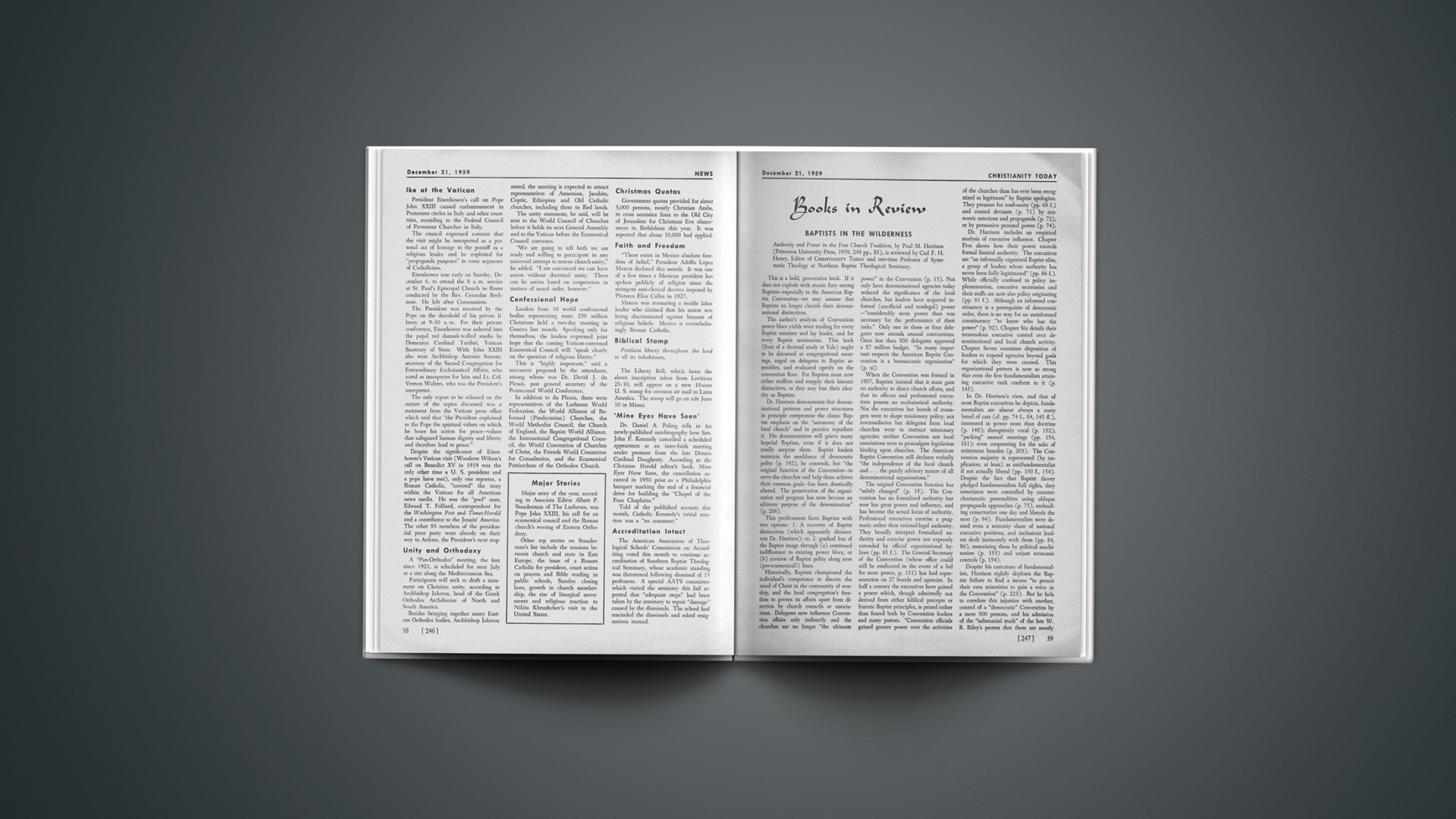Baptists In The Wilderness
Authority and Power in the Free Church Tradition, by Paul M. Harrison (Princeton University Press, 1959, 248 pp., $5), is reviewed by Carl F. H. Henry, Editor of CHRISTIANITY TODAY and one-time Professor of Systematic Theology at Northern Baptist Theological Seminary.
This is a bold, provocative book. If it does not explode with atomic fury among Baptists—especially in the American Baptist Convention—we may assume that Baptists no longer cherish their denominational distinctives.
The author’s analysis of Convention power blocs yields must reading for every Baptist minister and lay leader, and for every Baptist seminarian. This book (fruit of a doctoral study at Yale) ought to be discussed at congregational meetings, urged on delegates to Baptist assemblies, and evaluated openly on the convention floor. For Baptists must now either reaffirm and reapply their historic distinctives, or they may lose their identity as Baptists.
Dr. Harrison demonstrates that denominational patterns and power structures in principle compromise the classic Baptist emphasis on the “autonomy of the local church” and in practice repudiate it. His documentation will grieve many hopeful Baptists, even if it does not totally surprise them. Baptist leaders maintain the semblance of democratic polity (p. 192), he contends, but “the original function of the Convention—to serve the churches and help them achieve their common goals—has been drastically altered. The preservation of the organization and program has now become an ultimate purpose of the denomination” (p. 206).
This predicament faces Baptists with two options: 1. A recovery of Baptist distinctives (which apparently disinterests Dr. Harrison); or, 2. gradual loss of the Baptist image through (a) continued indifference to existing power blocs, or (b) revision of Baptist polity along new (pro-ecumenical?) lines.
Historically, Baptists championed the individual’s competence to discern the mind of Christ in the community of worship, and the local congregation’s freedom to govern its affairs apart from direction by church councils or associations. Delegates now influence Convention affairs only indirectly and the churches are no longer “the ultimate power” in the Convention (p. 15). Not only have denominational agencies today reduced the significance of the local churches, but leaders have acquired informal (unofficial and nonlegal) power—“considerably more power than was necessary for the performance of their tasks.” Only one in three or four delegates now attends annual conventions. Once less than 500 delegates approved a $7 million budget. “In many important respects the American Baptist Convention is a bureaucratic organization” (p. xi).
When the Convention was formed in 1907, Baptists insisted that it must gain no authority to direct church affairs, and that its officers and professional executives possess no ecclesiastical authority. Not the executives but boards of managers were to shape missionary policy; not intermediaries but delegates from local churches were to instruct missionary agencies; neither Convention nor local associations were to promulgate legislation binding upon churches. The American Baptist Convention still declares verbally “the independence of the local church and … the purely advisory nature of all denominational organizations.”
The original Convention function has “subtly changed” (p. 15). The Convention has no formalized authority but now has great power and influence, and has become the actual locus of authority. Professional executives exercise a pragmatic rather than rational-legal authority. They broadly interpret formalized authority and exercise power not expressly extended by official organizational bylaws (pp. 81 f.). The General Secretary of the Convention (whose office could still be eradicated in the event of a bid for more power, p. 131) has had representation on 27 boards and agencies. In half a century the executives have gained a power which, though admittedly not derived from either biblical precepts or historic Baptist principles, is prized rather than feared both by Convention leaders and many pastors. “Convention officials gained greater power over the activities of the churches than has ever been recognized as legitimate” by Baptist apologists. They pressure for conformity (pp. 69 f.) and control deviants (p. 71) by economic sanctions and propaganda (p. 72), or by persuasive personal power (p. 74).
Dr. Harrison includes an empirical analysis of executive influence. Chapter Five shows how their power exceeds formal limited authority. The executives are “an informally organized Baptist elite, a group of leaders whose authority has never been fully legitimated” (pp. 86 f.). While officially confined to policy implementation, executive secretaries and their staffs are now also policy originating (pp. 91 f.). Although an informed constituency is a prerequisite of democratic order, there is no way for an uninformed constituency “to know who has the power” (p. 92). Chapter Six details their tremendous executive control over denominational and local church activity. Chapter Seven examines disposition of leaders to expand agencies beyond goals for which they were created. This organizational pattern is now so strong that even the few fundamentalists attaining executive rank conform to it (p. 143).
In Dr. Harrison’s view, and that of most Baptist executives he depicts, fundamentalists are almost always a nasty breed of cats (cf. pp. 74 f., 84, 145 ff.), interested in power more than doctrine (p. 148); disruptively vocal (p. 152); “packing” annual meetings (pp. 154, 161); even cooperating for the sake of retirement benefits (p. 203). The Convention majority is represented (by implication, at least) as antifundamentalist if not actually liberal (pp. 150 f., 154). Despite the fact that Baptist theory pledged fundamentalists full rights, they sometimes were controlled by counter-charismatic personalities using oblique propaganda approaches (p. 75), enthralling conservative one day and liberals the next (p. 94). Fundamentalists were denied even a minority share of national executive positions, and inclusivist leaders dealt insincerely with them (pp. 84, 86), restraining them by political machination (p. 153) and unjust economic controls (p. 154).
Despite his caricature of fundamentalists, Harrison rightly deplores the Baptist failure to find a means “to permit their own minorities to gain a voice in the Convention” (p. 223). But he fails to correlate this injustice with another, control of a “democratic” Convention by a mere 300 persons, and his admission of the “substantial truth” of the late W. B. Riley’s protest that these are mostly “salaried servants, many of them cogs in the machine” (p. 191).
Dr. Harrison holds that minimizing the power and authority of denominational leaders would threaten the achievement of common Baptist goals (p. x). Some Baptists are urging “recognition and acceptance” of the power of denominational leaders. “The Baptists have not succeeded in their program to check authority or to balance power.… It is a contradiction to give the executive official responsibility but no official authority” (p. 78). “But it is extremely difficult to make a formal change in the polity system without altering the doctrine of the church.” Therefore, a significant change legitimating present patterns of authority is unlikely “unless … preceded by a reinterpretation of doctrinal formulas” (p. 7).
Harrison is interested in revising rather than in preserving Baptist ecclesiology. He seemingly details ABC practical compromises in behalf of supra-Baptist views of the Church. “Already many Baptist leaders are asking critical questions about the Baptist theology of the church” (p. 6). Denominational leaders in general admit that “the local church has lost much of its cherished autonomy, and … significant power as the initiator of policy” (p. 100). For Baptists now “insist upon allegiance to a doctrine of the church which they do not follow in their actual polity” (p. 9). “Ideas about the nature of the church” are undergoing change “as a result of adjustment to new situations” (p. 14; cf. p. 63). In 1954, an American Baptist Theological Conference Committee [did the executives select the participants?] “observed that authority extends beyond the limits of congregational membership” (pp. 57 f.).
“Although the officials of the Convention theoretically possess no ecclesiastical authority, their actual power is great enough to exert tremendous pressure upon the traditional beliefs of the Baptists” (p. 13). There are signs, in fact, that the informal power of the executives is gradually becoming formally legitimated. Mimeographed semi-official literature, emerging from theological and organizational conferences, contains “realistic appraisals of the situation of the local church, that is, dependent upon the Convention for its meaningful existence” (p. 100).
The inherited Baptist view of local church autonomy, Harrison thinks, is indebted to the seventeenth century cultural milieu (p. 11). The basic Free Church tenets were shared by early Presbyterianism, we are told (p. 21), whereas American Baptists have “absolutized” local autonomy (p. 26). The reader will note that the Baptist view of autonomy is overdrawn by Harrison’s implication that it necessarily obscures the unity of the body of Christ (pp. 219, 222).
It is not surprising that, with an eye on ecumenical patterns, Dr. Harrison then dissolves Baptist distinctives and bridges to Presbyterianism (pp. 218 f.). We are told that historic Baptist “democratic polity” expects more from regenerate believers than traditional Christian doctrine supports (p. 60). “Baptists have been seeking in vain for a valid and rational locus of ecclesiastical authority under God” (p. 217). Some younger men in the denomination look hopefully toward a representational (Presbyterian) polity, and “most Baptists seem in agreement that this method is “second best” (p. 99). The veiled power of denominational leaders is often already “considerably greater than the official ecclesiastical authority of the Episcopalian or Methodist bishop, or the Presbyterian moderator” (p. 92). The “autonomy” of the various denominational societies is already “more fictional than real” (p. 123). Many leaders think “the general council must assume a more significant role” (p. 121), that of coordinating head, although the Council on Missionary Cooperation also holds much power (p. 128). Reorganization toward greater central authority has been discussed along several lines by the denominational publication Crusader (p. 122).
Professor Harrison grants to separationists that “organized Christianity” represents a “compromise of the Gospel” (p. 204). But anybody can invoke the Bible to bulwark his own prejudices, he says, and “inroads into the authority of the Bible” by biblical criticism demand “a more sophisticated understanding of biblical authority” (p. 217). It is not apparent what comfort these assumptions should afford Dr. Harrison in projecting an alternative polity.
His own proposal is: “If local churches are to be free from domination by a secular power or from the authority of an ecclesiastical oligarchy, they must associate with one another, each recognizing the authority of the other, none claiming absolute autonomy or authority, and all recognizing the temporal but pre-eminent authority’ of the association of churches so long as they wish to derive the advantages of associational membership” (p. 220). But his argument for associational polity is not merely pragmatic. Baptists of the past would find headline news (probably carrying an Amsterdam or Evanston dateline rather than a New Testament text) in word that: “From the doctrine of the priesthood of all believers and the doctrine of original sin it follows that no single unit of the church can discern the mind of Christ in its fullness if separated from all other local units as well as from the associations and from the American Baptist Convention” (p. 224). Is not the next stop on this ecclesiastical expressway, we may ask, the National Council of Churches, and then the World Council? And perhaps Rome? (When the Convention was first projected, many Baptists feared a “first step on the road to Rome.” A professor at Newton, J. B. Thomas, even thought it necessary to emphasize that Baptists alone had resisted the Presbyterian tendency to “take the authority from the mass of the people and give it to an official body.”)
The “containment” of professional executives along lines suggested by Dr. Harrison seems actually to involve the substitution of one non-Baptist polity for another, and to be dictated by an eye on ecumenical trends rather than on Baptist distinctives. Dr. Harrison looks expectantly in the direction of “new apprehensions of the faith” and “new and more adequate social forms” (p. 224). “Until these are developed it appears that the Baptists must return to some kind of associational discipline. If the congregations were united in associations … the association would legitimately proclaim the Word as discerned by the united churches” (p. 224, ital. sup.). This may offer some dispersal of ecclesiastical power (while assimilating Baptists to Presbyterians). But does it not also dissolve the Baptist distinctives of soul competence and local church autonomy? Dr. Harrison nowhere proposes tenure for professional executives (now often positioned to assure their own permanence by determining the personnel of the very boards who nominate and elect them), nor a curtailment of powers to legal limits. He simply tells us that ecclesiastical policy formulation on traditional Baptist premises is impossible (p. 94). He proposes to narrow the gap between authority and power, not by minimizing the power of leaders, but by widening official authority (p. 177).
The survey discloses a distressing evasion of theological issues by Convention leaders (pp. 145 ff.). “Theology became … a symbol of denominational conflict” (p. 148); as a result, many executives are theologically indifferent, and interested primarily in Convention support (p. 149). Whatever hinders the promotional program is viewed as divisive (p. 179). Yet for six years, after 1950, the American Baptist Convention lost a member an hour, more than 10,000 members a year.
Dr. Harrison does not detail the longstanding tensions between the executives (promoting centralization of power) and the denominational seminaries (promotive of decentralization, at least in evangelical schools, by emphasis on classic distinctives and the illegitimacy of liberalism as an authentic expression of Christianity). In the past decade, however, conservative seminaries have yielded more and more ground, if not through neo-orthodox theological concessions, then through appeasement of Convention pressures for the production of “wholly loyal” alumni, and through direct financial dependence upon the Convention.
What Baptists most need, to justify their survival, is a theological and evangelistic awakening. Too long have they served the wrong kind of “power from above.” Whether they can recover from this idolatry, or whether they will lose identity as Baptists, may be decided more quickly than most Baptists dream. If denominational leaders respect free and mutual criticism as a basic element of Baptist polity, they have boundless potential for it in this exposition of discrepancy “between the Baptist doctrine of the church and the polity of the American Baptist denomination.” Dr. Harrison’s study could supply incentives for earnest probing of Baptist doctrine and practice. If Baptists shun this duty, or timidly repress their convictions, the death rattle of a great denomination may sound in the silences.
CARL F. H. HENRY
The People’S Archbishop
William Thomson, Archbishop of York, by H. Kirk Smith (S.P.C.K., London, 190 pp., 35s.), is reviewed by T. G. Mohan, Secretary, Church Pastoral Aid Society, London.
This well-written biography, which holds one’s attention from beginning to end, is of special interest and importance because it provides a measure by which we can assess the drift of the Church of England during the last 100 years backwards to the pre-Reformation pattern.
The churchmanship and spiritual outlook of Archbishop Thomson appears to be much like that of a “Conservative Evangelical” today, in fact like that of the Book of Common Prayer and the Thirty Nine Articles which are still the official formularies of the Church of England. Had he been Archbishop of York at the present time he would no doubt have been called a “fundamentalist”; indeed we are told that “Thomson’s attitude to biblical study was fundamentalist” (p. 35). We are left in no doubt about his greatness—his commanding appearance, his powerful voice, his administrative ability, his gifts as a preacher, his tireless energy, and his faithfulness as a pastor. But all this seems to the author to be overshadowed by Thompson’s evangelical bent of mind which was “man-centered rather than God-centered. He believed that the primary function of the Church was not to worship her Creator through Jesus Christ in the power of the Holy Spirit, but rather to gather in the harvest of lost souls” (p. 31). Or again: “It was what Christ had done for him, was doing for him, and would do for him, rather than the all-consuming desire to offer worship and adoration to the Sovereign Lord of all creation, which formed the basis of his religion. It was, in a sense, self-centered rather than God-centered” (p. 168).
His attitude to the Bible is defective we are told, because he accepts its sole authority; his doctrine of the church is defective because he does not consider its primary purpose as worship (i. e. acts of worship in church); his doctrine of the sacraments is defective because they are not, for him, central in the scheme of man’s redemption; his doctrine of the ministry is defective because he does not believe in apostolic succession, consequently the sacrament of penance is distasteful to him. A striking illustration of his defective churchmanship is his permission given to 400 Salvationists to receive Holy Communion in St. Paul’s, York—described by the Church Times as “one of the saddest spectacles seen in the Church of England for a long time” (p. 32).
The author seems to accept the modern view that a trend which persists until it becomes popular must therefore be accepted as progress. Refusal to accept is a failure to move with the times. “It was Thomson’s tragedy,” he says, “… that his theology did not develop with his experience” (p. 30). Though it is admitted that his attitude to the Oxford Movement “was in line with the general Anglican position in the middle of the nineteenth century,” yet he “fell behind the best spirit of the age,” he was “unable to keep abreast of the times.” (This was no doubt the complaint made of Athanasius by his contemporaries!) Of his attitude to another danger—the spread of radicalism and materialism—it is said that his “penetratingly shrewd and essentially practical outlook enabled him to grasp the true significance, and trend, of events” (p. 65).
Perhaps he was equally farsighted in being able to see where the trend of ritualism would lead the church, and the danger of drifting with the tide under the guise of moving with the times. In one respect, at least, he was proved correct, namely in his belief that “ritualism was unacceptable to the broad mass of the laity, and to the common sense of the nation” (p. 40). It is a fact that the period during which ritualism and its teaching have spread their influence in the church has also been the period during which the nation, which could be described as one of the most religious the world has ever seen, has ceased to be a worshiping people. It is also perhaps significant that “Thomson’s greatest triumph was the way in which he changed the attitude of the working classes in the large towns of his diocese towards the office he held, and so to the church” (p. 152). The working men of Sheffield took him to their hearts. He is described on a memorial in the Cathedral as “The People’s Archbishop.” It is also perhaps worth mentioning that, like the great evangelical whom our author calls “the bigoted Shaftesbury,” his death was mourned by the common people. “Sixteen Sheffield working men carried his (Thomson’s) body to its resting place.”
One final comment may be made on the significance of the times in which we live. It is that this book is written by one who himself has been identified with the evangelical school of thought.
T. G. MOHAN
Preaching Christ
Ruth, by Charles E. Fuller (Revell, 1959, 123 pp., $2), is reviewed by the Reverend Frank A. Lawrence, Minister of Graystone United Presbyterian Church, Indiana, Pa.
The founder of the “Old-Fashioned Revival Hour” has collected 10 of his sermons on the book of Ruth which he has given to his world-wide radio audience. Dr. Fuller subtitles his book, “A Life of Love and Loyalty,” but it would be more accurate to call it, “How to Preach Christ from the Book of Ruth.” Here is a good example of the type of preaching suggested by the honored axiom, “Wherever I land in the Scripture I strike cross-country for the Cross.” That is what Dr. Fuller has done.
He will be open to the charge of allegorizing. Certainly weak points consist in his omission of the historical aim of the book (tracing the ancestry of David), and his failure to show that from the beginning God was supranational. But it is a rich volume of meditations on Christ by type in Ruth, and could be an ideal invitation to the lost. It is compact, attractive, easy to read, and on target.
FRANK A. LAWRENCE
Subjective Hermeneutics
Interpreting the Bible, by J. C. K. von Hofmann, translated by Christion Preus, (Augsburg, 1959, 236 pp., $4.50), is reviewed by F. R. Webber, of Mount Vernon, N. Y.
The man who teaches dogmatics in a great university commands respect. If he has a heavy, gutteral accent he is, like Caesar’s wife, beyond reproach. Thus say many people. Perhaps this is why we have had a rash of books by and about theologians of the German-Swiss way of thinking. Were these the writings of the great dogmaticians of the Age of Orthodoxy (1517–1713), all might be well. That period produced such great names as Luther, Chemnitz, Hunnius, Hutter, Gerhard, Koenig, Calovius, Quenstedt, Baier, and Hollaz among the Lutherans, and Zwingli, Calvin, Bullinger, Keckermann, Wolleb, Alsted, Alting, Maccovius, Maresius, Voetius, Heidegger, and Leydecker among the Reformed. When David Hollaz died in 1713, orthodox Lutheranism died. When Melchoir Leydecker died eight years later Reformed orthodoxy came to an end. After an interval of pietism, theology lapsed into doctrinal indifference, then into the age of rationalism, although by the grace of God, bright theological lights appeared from time to time and proclaimed evangelical truth in the theological twilight.
It was the age of rationalism that laid out the red carpet for Schleiermacher, Hofmann, Frank, and the Erlangen Ich-theologie school. What is Ich-theologie? Other names for it are the Ego-theology, subjective theology, and “pious self-consciousness.” There are four attitudes toward the source of Christian doctrine. Theologians of the pre-Reformation period found the fountain head of all Christian doctrine in the Church and its popes and councils. The rationalists looked for it in man’s reason. Schleiermacher, Hofmann, and Frank declared it to be in the Ich-theologie of the theologian. The true theologian finds it solely in the Scriptures.
Johann C. K. von Hofmann (1810–1877) was professor at Rostock and Erlangen. He is often called the father of the Erlangen school and founder of modern subjective religious thinking. This is not correct. F. D. E. Schleiermacher (1768–1834) was proclaiming that Christian doctrine is drawn from man’s inner consciousness, and not from the Scriptures, while Hofmann was yet a schoolboy. Where the theologians of the Age of Orthodoxy searched the Scriptures for Christian truth, the Ego-theologians searched their own hearts. They scoffed at those who made an idol of an infallible Book, and then they straightaway made an idol of fallible man.
While Hofmann’s Biblische Hermeneutik, of which interpreting the Bible is a translation, is concerned with the principles that govern the understanding of the Scriptures, Hofmann’s thinking is colored by his previous writings like Der Schriftbeweis (1852–56) and his works on prophecy. In these books he betrays the fact that he is neither a gnesio-theologian nor was he conservative. He denies verbal inspiration, original sin, the vicarious atonement, justification by grace through faith, sola Scriptura and the pre-incarnation existence of the Lord Jesus.
Hofmann’s book contains the same ambivalence that one finds in De Wette and Ritschl who were skilled in expressing their new teachings in the old language of orthodoxy. Hofmann cites many portions of Scripture whose integrity he frankly questions, and at the same time he professes to believe that the Bible is God’s Word, miraculous in origin and content, and a witness to the saving truth. His hermeneutical method is based upon the theory that one must not begin with Scripture passages that pertain to sedes doctrinae, or individual doctrines. Rather he must begin with the Scriptures as a whole. This is a familiar device of those who would leave room for human rationalizing. It recalls Schleiermacher who said, “Quoting individual Scripture passages in dogmatics is dangerous, yea, in and by itself unsatisfactory” (Glaubenslehre I:30). Frank and Ihmels were others who favored Hofmann’s procedure.
Dr. George Stoeckhardt calls this method “nothing but a new style of rationalism, rationalism in a churchly dress … which by its own authority passes judgment in matters of faith and truth, which fabricates and sets up doctrines, which from within constructs God, heaven, earth, and everything in an arbitrary manner, and is at bottom the ‘I,’ the ‘spirit,’ the ‘inner light’ of the enthusiasts” (Lehre und Wehre, 42:74).
Dr. Christian Preus, translator of the Hofmann book, is one of a far-flung relationship of Norwegian ancestry. They have produced a number of theologians, professors, and parish clergymen. He has succeeded well in translating Hofmann’s crabbed, ponderous sentences into pleasing English.
F. R. WEBBER
Religious Brain-Washing?
Conversions, Psychological and Spiritual, by D. Martyn Lloyd-Jones (London: The Inter-Varsity Fellowship, 40 pp., 2s.), is reviewed by Owen Brandon of The London College of Divinity.
There is no doubt that the publication of Dr. William Sargant’s book, Battle for the Mind, in 1957, caused a stir in informed circles. Dr. Sargant described his work as “a physiology of conversion and brain-washing,” and in it he showed the similarities, from the purely human point of view, of the mental processes involved in political brain-washing, in psychoanalysis, and in religious conversion.
The little book now under review is written as a critique of Battle for the Mind. It is the substance of an address to Christian ministers given under the auspices of the Evangelical Alliance at High Leigh, Hoddesdon, Herts. Dr. Martyn Lloyd-Jones felt impelled to write this critique because of Christian men and women, some of them undergraduates, who had been “profoundly disturbed” by Dr. William Sargant’s book, and who were beginning to wonder whether, after all, their own conversion could have been but the result of the religious use of psychological techniques.
Dr. Lloyd-Jones’ critique is in three parts. First, he outlines Dr. Sargant’s main thesis, which he (Dr. Sargant) had built up on a study of religious conversion against the background of his own knowledge and experience as a practicing psychiatrist. His thesis is that conversion follows the general pattern of conditioning, anxiety, collapse and reorientation. These are the processes common also in political brain-washing and much psychological treatment. In the second part of the work, Dr. Lloyd-Jones examines Dr. Sargant’s thesis. In this he attacks Dr. Sargant at the weakest points of his book, namely, in his exposition of biblical passages; and he also challenges Dr. Sargant’s expositions of the conversion experience of John Wesley. In the last part of his critique, Dr. Lloyd-Jones turns to the positive value of Dr. Sargant’s study. Here our author has some strong and positive words to say about some contemporary methods of evangelism. Dr. Lloyd-Jones agrees with Dr. Sargant that it is possible, by various means and methods and mechanisms, to influence the human mind, even in the religious sphere; and he raises the question: Is it not the case that some of our methods and approach to evangelism arouse suspicion? There are dangers, he says, in too great an eloquence, or too strong an appeal in evangelism. He deprecates a direct appeal either to the emotions or to the will. The appeal must be to the mind. “The normal course is for the emotions and the will to be affected by the truth after it has first entered and gripped the mind.” Thus, Dr. Lloyd-Jones uses the validity of much of Dr. Sargant’s argument to call for a serious reconsideration on the part of evangelicals in regard to their motives and their methods of evangelism.
This is an interesting critique of the thesis of one Doctor of Medicine by another Doctor of Medicine who is also a Christian minister. But I think that its significance can be appreciated only by those who have read the bigger work by Dr. Sargant. Elsewhere I have maintained that Dr. Sargant’s Battle for the Mind should be read by all ministers and evangelists. Dr. Lloyd-Jones’ little book may well be read alongside it, but the reading of the critique is no substitute (for the serious student) for the reading of the larger work.
OWEN BRANDON
The Paraclete
Emblems of the Holy Spirit, by F. E. Marsh (Kregel, 257 pp., $2.95), is reviewed by Eric Edwin Paulson, Minister of the Lutheran Free Church.
Although millions of Christians confess every Lord’s Day their belief in the Holy Spirit, only a scant fraction possess adequate knowledge of the divine Executive of the Church. This volume furnishes a detailed explanation of the symbols of the Holy Spirit found in the Scriptures. This is done with a freshness and originality seldom excelled, plus sound exegesis.
It is plain that the author’s knowledge has been gained through daily living and serving in the power of the Holy Spirit, as well as through painstaking scholarship. The book is attractively illustrated and should prove to be useful to every young preacher and student of the Word of God.
ERIC EDWIN PAULSON
Sunday School Lesson Helps
Standard Lesson Commentary 1960 International Sunday School Lessons, edited by John M. Carter (Standard Publishing Company, 1959, 448 pp., $2.95); The Douglass Sunday School Lessons for 1960, by Earl L. Douglass (Macmillan, 1959, 475 pp., $3.25); Broadman Comments 1960, by H. I. Hester and J. Winston Pearce (Broadman Press, 1959, 433 pp., $2.95); The International Lesson Annual 1960, by Charles M. Laymon and Roy L. Smith (Abingdon, 1959, 448 pp., $2.95); Tarbell’s Teachers’ Guide—1960, by Frank S. Mead (Revell, 1959, 384 pp., $2.95); and Peloubet’s Select Notes for 1960, by Wilbur M. Smith (W. A. Wilde Co., 1959, 423 pp., $2.95), are reviewed by Milford Sholund, Director of Biblical and Educational Research, Gospel Light Publications, Glendale, California.
Millions of Christians continue to use the International Sunday School Lessons and the International Bible Lessons for Christian Teaching. Comments on the Outlines of the International Bible Lessons for Christian Teaching and the Uniform Series are cherished by Bible students in Sunday schools, homes, hospitals, prisons, schools, and pastors’ studies everywhere. Since 1872, when the uniform lessons were first devised as a practical way of teaching Sunday School, billions of words have been written and printed for teachers of pupils of all ages.
Sunday School teachers in 1960 will find plenty of material to consider for their classes in the six volumes reviewed.
There are four sections of 13 weeks with the following topics: First quarter: The Acts of the Apostles; second quarter: Sermon on the Mount and Parables; third quarter: Century of Great Prophets; fourth quarter: Passages of Spiritual Power.
If you buy all six volumes, you will invest $18. Each volume is $2.95 with the exception of Douglass which is $3.25.
With these six volumes lying open before you, what do you expect to find? First of all, these are substantial books in size. Only one has less than 400 pages (Mead, 384 pp.). Second, you will be impressed with the format or the layout of the printed page. There is a uniformity about the massive amount of printing on each page. Carter comes closer to giving variety by including pictures, boxes with outlines, charts, sketches, and a three-column page. It is easier to read a shorter line.
Four authors use the King James version as the printed text, while two authors, Mead and Laymon, use both the King James and the Revised Standard versions in parallel columns. It is interesting to note that the King James version continues to be a favorite among users of the comments on the International Uniform Lessons.
There is an interesting mixture of the old and new in these six commentaries. Smith draws heavily on ideas of expositors of the nineteenth and early twentieth centuries. There are quotations from Spurgeon, Hengstenberg, Morgan, Delitzsch, and others. Mead tends to quote from contemporary sources including Robert McCracken, Reader’s Digest, J. R. Sizoo, and James C. Worthy, vice-president, Sears Roebuck Company. The reader can find pretty much what he likes in the six volumes.
All of the comments are limited to a given biblical text for a particular lesson. There is a wide divergence, however, in the way this text is explained, developed, and related to life today. Laymon, Mead, and Smith have more direct development of the text. Douglass, Carter, and Hester seem to be more aware of the need for getting the teacher and student involved in the significance of the biblical truth for today.
Audio-visual materials to be used with the development of the lessons are featured by Douglass, Mead, and Smith. These materials include films, filmstrips, flat pictures, and supplimentary materials. There are some excellent lists of films and filmstrips that could be deposited in Sunday School libraries for general use.
The value of these six commentaries is not limited to lay-teachers. Pastors and instructors in seminaries, colleges, and Bible institutes will find a wealth of material condensed on these pages.
MILFORD SHOLUND
More Than Appendage
He Ascended into Heaven, by J. G. Davies (Association Press, 1958, 224 pp., $4.75), is reviewed by Walter W. Wessel, Professor of New Testament, North American Baptist Seminary, Sioux Falls, S. D.
Bampton Lectures are usually scholarly and competently written. This one is no exception, and it has the added attraction of being concerned with a strangely neglected subject, the Ascension of our Lord. So rare are books on the Ascension that the last definitive one in English, H. B. Swete’s The Ascended Christ, appeared back in 1910, and much of it was not concerned with the Ascension proper! The neglect of this doctrine over the past half-century has been largely due to the scientific spirit of our age. The Lukan account with its pre-Copernican cosmology caused many to refuse to take it seriously. Adolf Harnack’s contention that not only the cosmology of Luke was suspect but also the account itself, came as a welcomed relief and apparently stifled reinvestigation of the subject for many years. Davies now comes with a fresh and thorough study of the Ascension.
The problems which surround this doctrine are many and formidable. What is the theological significance of the Ascension? Is there any doctrinal distinction between the Ascension and the Resurrection? Was the Ascension an historical event or is the New Testament account a pictographical means of conveying the idea of transference from one condition of being to another? Are the New Testament accounts at variance with one another, particularly in relation to the time of the event?
To find answers to these questions Dr. Davies begins in the Old Testament where the Ascension is prefigured and predicted, works through the New Testament passages which bear witness to the event, and concludes with a study of the history of the doctrine from the earliest fathers of the Church to the writers of the eleventh and twelfth centuries. The entire study is conducted in the best tradition of biblical scholarship.
The real strength of this book lies in the author’s exposition of the New Testament passages (far more numerous than one might suppose) and his clear statement of the theological significance of this doctrine. The Ascension is rescued from being a mere appendage to the great saving events of our faith. Dr. Davies rightly asserts that “if it is through the Ascension that Jesus entered upon the office of Son of Man, became no longer Messias designatus but Messiah indeed, and received the regal dignity and title of ‘Lord,’ then the Ascension belongs not to the periphery but to the heart and substance of the Gospel” (p. 169).
Many will disagree with some of Dr. Davies’ conclusions, for example, that the Ascension actually took place on Easter night and that the account of a 40 day interval in Acts is a deliberate accommodation for typological reasons. However, every student of the New Testament will welcome the forthright manner in which Dr. Davies faces up to the problems associated with the Ascension, and will commend the scholarly competence by which he searches for solutions. These factors make this book a truly significant one in the area of biblical theology.
WALTER W. WESSEL
A Son Of Thunder
Minority of One, by Clyde S. Kilby (Eerdmans, 1959, 219 pp., $3.95), is reviewed by Henry W. Coray, Author of Son of Tears.
This delightful biography of the founder of Wheaton College coincides with the institution’s one hundredth anniversary. The book could be labeled fittingly, Man on a Soapbox. For Jonathan Blanchard was at once a preacher of the Gospel, a fierce abolitionist and temperance worker, an almost fanatical antagonist of secret societies, an able educator (he fathered Knox College as well as Wheaton), and a militant journalist. The man was a walking paradox: he declared himself to be both premillennialist and postmillennialist; he brushed shoulders with Stephen A. Douglas, Whittier, Salmon P. Chase, Thaddeus Stevens and Owen Lovejoy, and yet loved to be with derelicts and slaves; and he was a warmhearted friend, and the most intolerant of foes. Once on a train he planted a beautiful haymaker on the jaw of an insulting individual, pleaded guilty to assault in court, and cheerfully paid the three-dollar fine.
Mr. Blanchard’s convictions brought him into collision with large segments of the political and educational worlds of his day. Conflict was his normal diet. His tempestuous career, like Paul’s, was marked by evil report and good. Dr. Kilby has etched his profile in clean sharp lines. The effect: a nineteenth century son of thunder testifies to a mid-twentieth century that is in danger of going to sleep under the soft strains of a Hearts-and-Flowers epistemology that has in reality set itself unremittingly against the Lord. A friend described Jonathan Blanchard as “a modern Cromwell, a true iconoclast ‘smiting the godless shrines along his path’,” and added, “I loved him as a man, an instructor, a hero. He did not know the first rudiments of fear.”
HENRY W. CORAY
Bible Exposition
God’s Wrath, by Donald Grey Barnhouse (Eerdmans, 1959, 286 pp., $3.50), is reviewed by Harry Buis, author of The Doctrine of Eternal Punishment.
Dr. Barnhouse has been preaching on the epistle to the Romans each week for over eight years. This book is one of a series of five which has appeared thus far as a fruit of this preaching. The volume covers Romans 2:1–3:20. Each chapter expounds in order one, two, or occasionally more verses. The jacket describes the series as an “Exposition of Bible Doctrines taking the Epistle to the Romans as the point of departure,” which is true; but fortunately the departure from the text is not nearly so great as that of many who do not so warn us that they plan to depart!
These messages are sound biblical expositions, which is not to say that all evangelicals will fully agree with the interpretation of every passage. With a note of authority which ought to characterize all Christian preaching, the author drives home the theme of this section of Scripture: Men are utterly lost in sin and therefore their only hope is to come to Christ. The short but very clear illustrations scattered throughout these messages are most helpful, as are the occasional word studies.
H. BUIS










